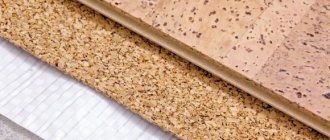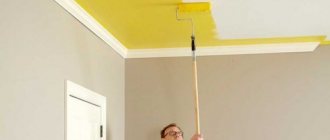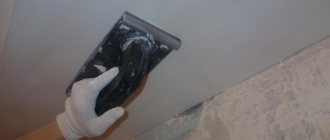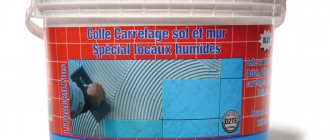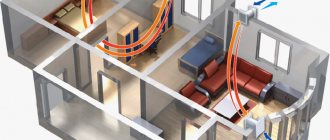It is possible to ensure coziness and comfort in an apartment in a panel house if you muffle all extraneous sounds. Unfortunately, when building multi-storey buildings, the developer is little concerned about the soundproofing properties of walls and ceilings, so apartment owners have to do the soundproofing themselves. It is worth noting that it is possible to effectively protect an apartment from sounds provided that the room is completely soundproofed, from the floor to the ceiling.
Photo: Sound insulation without frame. Author: Dmitry Kotov
Today the market offers a huge selection of sound insulation that can be used in a residential apartment, but it is important to choose the right material. Depending on the square footage of the room, the optimal sound insulation system is selected. If the room has a fairly large area and high ceilings, then a frame soundproofing system would be an ideal option. When the parameters of the room are relatively small, frameless sound insulation of the ceiling is suitable in order to save space.
Selecting the level of protection
To ensure reliable protection from extraneous sounds, it is necessary to select the correct level of protection. Effective soundproofing of ceilings depends on various factors:
- selection of insulating material;
- absorbent layer thickness;
- how many layers of insulating material are used;
- appearance of the finishing layer.
When choosing a material for sound insulation, it is important to approach the issue responsibly. Each insulating material has its own characteristics and characteristics, on which the quality of sound insulation will depend. All materials have different sound insulation properties, so such a responsible task as choosing materials should be entrusted to specialists who are well versed in this issue.
Photo: Sound insulation without frame. Author: Dmitry Kotov
Modern soundproofing materials differ in their characteristics and features. There are materials that, with a small thickness, provide effective and reliable protection. The only drawback of such materials is their cost, which is why most apartment owners prefer traditional, less expensive insulation options. When frameless ceiling sound insulation is installed, traditional materials are used, they should be installed according to the principle: thicker means better.
As for the number of layers used, experience shows that a combination of insulating materials copes most effectively with various types of noise. Multilayer frameless sound insulation of the ceiling in an apartment is the optimal solution, but you should look at the area of the room. In a small room, it is undesirable to use multi-layer “pies”, since the volume of the room will become even smaller, which is absolutely unacceptable.
Photo: Frameless sound insulation. Author: Dmitry Kotov
The final layer of sound insulation can be selected not only based on the characteristics of the material, but also on the appearance. Modern manufacturers produce finishing soundproofing materials in their original form, which sometimes helps in creating a specific interior design.
In an apartment with a high ceiling, you can use sound insulation consisting of numerous layers of material, without limiting the thickness of the insulating layer. To effectively protect the ceiling in an apartment, a layer thickness of 7 to 12 centimeters is suitable. The combination of such an insulator will include:
- rolled sound reflecting material;
- sound-absorbing gypsum plasterboard and gypsum board;
- sound-absorbing membrane;
- finishing coating.
Frameless sound insulation scheme
This set of materials will protect the room from any sound and noise, which is why such a protection system is often installed in the nursery and bedroom.
As for apartments with low ceilings, everything is much more complicated here. Of course, a combination of layers is not excluded, and the thickness of the materials should be small. When using a multi-layer coating of small thickness, the ceiling is lowered by only three centimeters.
Some people install suspended ceilings to visually increase the space in the apartment, and in this case you can use any thickness. This method is optimal for apartments with low ceilings and small areas. Frameless soundproofing of the ceiling in an apartment and a glossy ceiling surface can lengthen and expand the available space.
Acoustic membranes
The most modern type of materials. They are distinguished by their excellent soundproofing properties, low thickness, environmental friendliness and fire resistance.
There are only two negative points: these materials have considerable weight, so it is preferable to mount them on a rigid frame, and they are quite expensive.
Acoustic membranes can be attached to the ceiling using special glue; there are also self-adhesive varieties of this coating. They can be used either in combination with other materials or as the only method of noise protection. It all depends on the characteristics of the room and the tasks being solved.
Sources and characteristics of noise
Photo: Making sound insulation.
Author: Dmitry Kotov There are two types of noise that can penetrate a room: airborne and impact. If we talk about the formation of airborne noise, then it is formed during a loud conversation, loud music and when there is a highway or metro line nearby. Airborne noise is the most common in apartments, since behind almost every wall, floor and ceiling there are neighbors with children and pets. Constantly hearing sounds not only interfere with sleep, but also lead to fatigue and nervous breakdown.
As for impact noise, it has the ability to be transmitted over hard surfaces. Impact noise is considered to be: walking in heels, working with power tools, or using powerful speakers and a sound amplifier. Depending on the type of noise, appropriate materials are selected. It is problematic to figure out on your own where and what material to use, and, therefore, you need to entrust this work to a master who is well versed in these issues.
Photo: Soundproofing with foam plastic. Author: Dmitry Kotov
In multi-apartment panel buildings, sounds can come from all sides, so soundproofing of the ceiling without a frame is done for all surfaces. If the building is made of brick, then this material absorbs sounds, so sound insulation needs to be done for the ceiling, and this will be quite enough. In the case of monolithic frame buildings, the thickness of the ceiling is much greater than the wall partitions, which means it is necessary to insulate the walls. Taking into account the design characteristics of the house, the optimal solution for reliable sound insulation of the apartment is selected.
Ways to combat airborne noise
There are many different options to combat airborne noise. Modern building soundproofing materials will reduce the noise level to 45 dB. To understand how effective this is, consider examples of noise volume in decibels:
- loud conversation – 55dB;
- working vacuum cleaner – 70/80dB;
- jet engine roar – 120dB.
Photo: Soundproofing with mineral wool.
Author: Dmitry Kotov As it becomes clear, when installing soundproofing, extraneous sounds will not be heard through the air. Proper sound insulation of a ceiling without a frame will ensure maximum comfort and coziness.
Ways to combat impact noise
Impact or structural noise occurs as a result of: drilling into a wall, moving furniture, playing music loudly through an amplifier with speakers. To protect an apartment from such sound, it is necessary to ensure high-quality insulation of the ceiling surface using materials that do not respond to vibrations. A wide range of materials allows you to choose exactly what you need.
Photo: The softer the material, the better. Author: Dmitry Kotov
Multi-layer ceiling sound insulation can effectively limit the access of sounds through the walls, the main thing is to choose the right materials. If upon arrival at a hardware store it is difficult to find the material you are interested in, you should contact the manager and consultant, who will tell you everything in detail and tell you what is best to take.
Types of soundproofing materials
You can provide high-quality sound insulation for the ceiling using various materials, which today are offered in a wide range in specialized stores. You can purchase sound insulation based on various parameters and characteristics. Effective protection is guaranteed if the material has certain density, elasticity and other characteristics.
Today, soundproofing materials can be divided into three main types:
- Rigid structure. The filler may consist of pumice, perlite or other porous material. Such products can absorb up to fifty percent of the noise coming from outside.
- Soft structure. The insulator is based on mineral and stone wool, fiberglass, and similar materials. This sound insulation provides up to 80 percent sound absorption.
- Semi-rigid structure. Such insulators include polyurethane foam and polystyrene. Such insulators retain up to 70% of noise.
Photo: Butt foam.
Author: Dmitry Kotov When choosing a suitable material, it is important to initially look at performance indicators; only in this case can you achieve a good result.
The most popular soundproofing materials
Today, the market offers a large selection of sound insulation, which is suitable for various types of surfaces, and you can choose the most suitable one.
Mineral wool
The structure of mineral wool is fibrous, which provides a high level of noise absorption. The material is made from inorganic raw materials. The material can be used not only as noise insulation, but also as thermal insulation. Mineral wool has a lot of advantages due to which it is often used in construction. The material does not burn at all and also does not emit harmful vapors or smoke. In addition, mineral wool has excellent air permeability, so it is not susceptible to the formation of fungi and mold. Excellent sound insulation for the ceiling, especially if suspended ceilings are used.
Expanded polystyrene
This material has a high level of noise absorption. It is made in slabs whose thickness varies from two to ten centimeters. For use in apartments, five-centimeter panels are used. The main feature of this material is that for its installation only an adhesive solution is needed. The plates are evenly glued to the surface, effectively protecting against all kinds of sounds.
Acoustic foam
The material is used for soundproofing ceilings with suspended and tensioned structures. The main advantage of the material is its ease of installation. The foam rubber is attached to a special silicone glue, and even double-sided tape. Thanks to its flat and smooth surface, the material can be used without finishing.
Based on the characteristics of the materials, you can choose the most suitable one, in accordance with the requirements, quality and cost.
Mineral wool
One of the most popular materials. In addition to good sound insulation, it allows you to solve the problem of insulating an apartment. It can be glued to the ceiling, but it is better to use a frame structure. The size of its cells should be chosen such that the insulation boards are inserted with some effort.
USEFUL INFORMATION: Calculate the amount of drywall and ceiling profiles: online calculator
It is recommended to cover the structural elements of the frame in the area adjacent to the ceiling with a special damper tape. It will not allow sound to travel through profiles or sheathing beams.
Mineral wool loses its properties when exposed to moisture, so it is necessary to ensure good waterproofing of the ceiling at the top, and at the bottom there must be a vapor barrier membrane. A solid ceiling layer of mineral wool will reduce the height of the room by at least 10 cm.
If the first priority is to ensure sound insulation rather than insulation, then you should choose mineral wool with the appropriate properties. You can focus on the name: “Shumanet”, “Shumostop”.
Frameless ceiling sound insulation systems
Photo: Sound-absorbing panels.
Author: Dmitry Kotov There are two options for ceiling soundproofing: frame and frameless. The first option is applicable in most cases if the apartment has high ceilings. If the ceiling height in the house is small, then the optimal solution would be frameless sound insulation. The frameless method of sound insulation is simpler and more accessible. You can carry out installation work yourself without involving specialists.
If you need to make inexpensive but effective sound insulation, then frameless ceiling sound insulation is the optimal solution in terms of saving time and money. Some types of insulation materials need to be covered with slabs or sheets of drywall.
Noise Canceling Options
The source of noise is various factors. Several effective methods have been developed to suppress them. The first is to completely soundproof the room. However, this option does not always justify the cost of it. Such sound insulation requires significant material costs and also reduces the area of the apartment. This is a minus if the apartment is already cramped. Therefore, an alternative option is proposed - soundproofing the ceiling.
This is a popular technology that can be used to solve the problem simply and quickly. A stretch ceiling has this feature: when stretched, a cavity remains between the floor slabs and the decorative surface. It creates a soundproofing effect.
Sound reduction layer
The cavity itself is filled with a material with a porous structure to increase noise-absorbing characteristics. For this, mineral wool is used.
Do-it-yourself ceiling soundproofing
Considering the fact that frameless ceiling sound insulation is mounted under tension structures, you can carry out the sound insulation process yourself without resorting to the help of specialists. As an insulating material, you can use various sound insulation options, ranging from mineral wool to products ready for painting.
Photo: Sound-absorbing panels. Author: Dmitry Kotov
Step-by-step instructions for installing sound insulation:
- As with any work surface, preparation is initially carried out. The essence of the preparation is to clean the ceiling surface from various defects and flaws. If there are peeling layers, they must be removed to the base. It is also important to inspect the surface for cracks and chips. Gaps and cracks should be covered with putty to provide maximum protection against sound penetration. The surface of the ceiling should be as flat as possible so that the material being mounted evenly lays down and holds.
- After roughing the ceiling, you need to clean the surface from dirt and dust. This process is easier to carry out if you have a stiff brush on hand. If the ceiling has whitewash, it is advisable to wash it off with water and a cloth. Even a slight layer of whitewash can negatively affect the fixation of soundproofing panels.
- Upon completion of cleaning, the ceiling surface is primed. The ceiling should be primed in two layers to minimize the formation of fungus and mold between the insulation and the surface. During priming, it is advisable to capture part of the side walls at a distance of twenty centimeters.
- When the surface is completely prepared, you can proceed to the installation of sound insulation. Depending on the material, fastening methods may vary. For frameless sound insulation, in most cases, special adhesive solutions are used, on which sound-absorbing boards are attached. The glue is applied to the ceiling with a special relief spatula. The technology for applying glue is similar to laying ceramic tiles.
- After applying the glue, the soundproofing board is attached. After application, the surface is pressed under a uniform load. It is necessary to hold the sheet for about two minutes so that the material sets a little. To better fix the sound insulation, you can use special dowels, but you will have to drill holes.
- When the first plate is fixed, glue is applied to the next sheet. At the junction of the grooves, the contacting surfaces must be coated with soundproofing sealant.
- The dimensions of sound insulation have a certain meaning, and if the slab does not fit in size, you need to carefully trim the material. It is important that the cut side is flat and fits snugly against the side wall.
- Depending on the soundproofing materials used, finishing cladding may be used. To avoid the difficulty of installing the cladding, many experts use polystyrene as sound insulation, which has a smooth surface and can be painted after drying.
Photo: The easiest soundproofing option.
Author: Dmitry Kotov If you set up the workflow correctly, then the preparation and installation of ceiling sound insulation can be completed quite quickly. Of course, by entrusting the work to professionals, everything will be done quickly and efficiently.
Required Tools
Correct installation of frameless sound insulation can only be ensured if you have the necessary tools. The list of tools is small, but all elements must be present.
Photo: Sealant required. Author: Dmitry Kotov
To install sound insulation you will need the following tools:
- A stiff brush to clean the ceiling surface from dirt and peeling layers of finish.
- A tape measure is used to measure dimensions and select the most accurate material.
- An embossed spatula with which to apply the adhesive solution.
- Adhesive mixture in ready diluted form. Today in construction stores you can buy glue, which is intended specifically for the installation of soundproofing materials.
- Construction level, to achieve the most even sound insulation surface.
- Fixing dowels or as they are also called fungi.
- In case of drilling holes, you will need a hammer drill and a Pobedit drill bit with a diameter of 6 mm and a length of 16 centimeters.
- Soundproofing material selected according to requirements and characteristics.
If you have all the tools, installation work is quite simple, and if you have the skills of a builder, then all the processes can be completed independently with your own hands.
Additional methods of sound insulation
Photo: Powerful sound insulation.
Author: Dmitry Kotov Today it is quite popular to increase sound insulation in apartments using acoustic tension fabric. This material is installed like regular fabric stretch ceilings, and the effect is due to the qualities of the fabric itself. Profiled fabric material effectively reduces noise levels.
Supporters of natural materials use cork ceilings as additional sound insulation. The material is attached to soundproofing boards and improves the effect. The texture of the material allows it to be used without additional finishing, if the appearance matches the overall interior design.
Photo: Sealing cracks. Author: Dmitry Kotov
Effective ceiling protection can be achieved by simultaneously using several layers of insulating material. This combination provides maximum sound insulation effect. Depending on the requirements of the apartment owner, you can select basic and additional materials for maximum sound insulation of the ceiling and the entire room.
Preparatory work
The quality and durability of the ceiling sound insulation under the tension fabric will directly depend on the preliminary preparation of the base surface.
- The old coating should be removed from the ceiling.
- Carefully seal all detected cracks and cracks with special sealants.
- It is imperative to apply a primer with antiseptic properties: after installing a stretch ceiling, it will be problematic to detect and remove mold or mildew that has appeared in time. The primer will also improve adhesion when gluing soundproofing materials.

